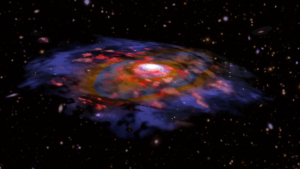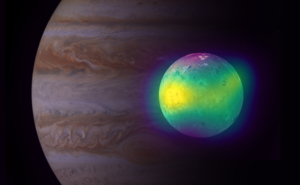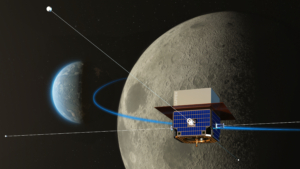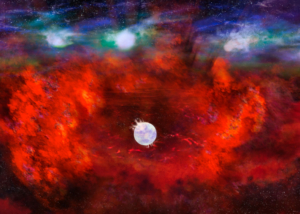Artist’s animation of a galaxy in the early universe that is very dusty and shows the first signs of a rotationally supported disk. In this image, the red color represents gas, and blue/brown represents dust as seen in radio waves with ALMA. Many other galaxies are visible in the background, based on optical data from VLT and Subaru.


Artist’s illustration of a dusty, rotating distant galaxy
Artist’s illustration of a galaxy in the early universe that is very dusty and shows the first signs of a rotationally supported disk. In this image, the red color represents gas, and blue/brown represents dust as seen in radio waves with ALMA. Many other galaxies are visible in the background, based on optical data from VLT and Subaru.

Volcanoes on Io
Composite image showing Jupiter’s moon Io in radio (ALMA), and optical light (Voyager 1 and Galileo). The ALMA images of Io show for the first time plumes of sulfur dioxide (in yellow) rise up from its volcanoes. Jupiter is visible in the background (Cassini image).

VLBA Finds Planet Orbiting Small, Cool Star
Using the supersharp radio “vision” of the National Science Foundation’s continent-wide Very Long Baseline Array (VLBA), astronomers have discovered a Saturn-sized planet closely orbiting a small, cool star 35 light-years from Earth. This is the first discovery of an extrasolar planet with a radio telescope using a technique that requires extremely precise measurements of a star’s position in the sky, and only the second planet discovery for that technique and for radio telescopes.
This artist’s illustration shows how the star’s motion around the center of mass between it and the planet causes a “wobble” in its motion through space. The VLBA’s ability to detect this minuscule effect revealed the presence of the planet.

Spacecraft DAPPER will study “dark ages” of the universe in radio waves
The National Radio Astronomy Observatory (NRAO) has joined a new NASA space mission to the far side of the Moon to investigate when the first stars began to form in the early universe.
This is an artist’s illustration of the Dark Ages Polarimetry Pathfinder (DAPPER), which will look for faint radio signals from the early universe while operating in a low lunar orbit. Its specialized radio receiver and high-frequency antenna are currently being developed by NRAO.

Neutron star in Supernova 1987A
This artist’s illustration of Supernova 1987A shows the dusty inner regions of the exploded star’s remnants (red), in which a neutron star might be hiding. This inner region is contrasted with the outer shell (blue), where the energy from the supernova is colliding (green) with the envelope of gas ejected from the star prior to its powerful detonation.





